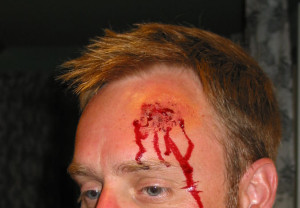With injuries to the head there is often a lot of bleeding, and can give the impression that the injury is a lot worse than it actually may be. This is because there are a significant number of small blood vessels which are situated very close to the skins surface. First Aid Classes therefore teach you to always reassure the patient in order to dispel any distress.
However, it is always important to gain the history from the patient or a witness as depending on the incident there could also be a neck, skull or internal injury. If you are in any doubt treat the patient for a head or spinal injury as a precaution.
Always wear disposable gloves if there are some available for both yours and your patients protection. Red Cross Training says if the wound has any displaced flaps of skin then gently replace them back over the injury.
You should cover the wound with a sterile dressing or a clean, non-fluffy pad and apply pressure to control the bleeding and reduce the amount of blood lost, thereby minimising the risk of shock. This can then be secured with a bandage to maintain the pressure.
St Mark James First Aid manual states any patient with a head injury must seek medical attention. Never leave them alone. You must continue to monitor the patient for any signs of reduced consciousness. You may be needed to open the patients airway and check their breathing, and should be ready to give CPR if required.
Eye Injuries
Any injuries to the eye have the potential of damaging the patients vision and therefore are very serious. The patient should be encouraged to lay flat and you should support their head and advise them to keep both eyes still, as movement can cause further damage. If available, First Aid Classes suggest you cover the injured eye with a sterile dressing or clean, non-fluffy pad whilst you await medical attention.
Nosebleeds
Nosebleeds often occur when the small blood vessels in the nostrils are ruptured. This can be from a blow to the nose, excess sneezing, blowing or picking the nose or even high blood pressure. Whilst nosebleeds are often not serious, prolonged bleeding can cause the patient to loose a lot of blood.
The patient with a nosebleed should always tilt their head forward, never back as this will allow blood to drip down the throat and could cause vomiting. Leaning their head forward, allows the blood to drain away. workplace approved Training says apply pressure to the soft part of the nose for 10 minutes to control the bleeding. If the bleeding continues, apply for 10 more minutes. If the bleeding is severe or it continues for more than 30 minutes then seek medical attention.
As previously mentioned, always gain a history from the patient as a nosebleed after a head injury can indicate a severe injury. The blood may be thin and watery which could be cerebral fluid which points to a skull fracture.
Bleeding from the Ear
When there is bleeding from the ear, this usually indicates a perforated eardrum. This can be caused by a blow to the ear, a foreign object or an explosion. Again, if the blood is watery or thin then it can indicate fluid leaking due to a fractured skull.
Tilt the patients head to the injured side to allow drainage of the blood and apply a sterile dressing or clean, non-fluffy pad to the ear. However, never tilt the head if you suspect a skull fracture. Reassure the patient whilst you await medical assistance.
REFERENCES
First Aid Manual (The Authorised Manual of St. John Ambulance, St Andrew’s Ambulance Association and the British workplace approved), 2006.
